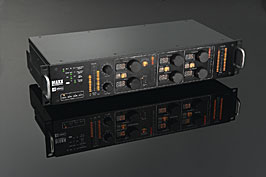Waves MaxxBCL Signal Processor
HARDWARE COMPRESSOR, BASS ENHANCER AND LIMITER
Although Waves is mainly considered to be a software company, it has occasionally released hardware that has been well-received in the industry, such as the discontinued L2 Ultramaximizer peak limiter and the MaxxStream narrow-band audio streaming box.
MEET MAXX
The first thing I noticed when I took the MaxxBCL out of the box is that it’s built like a tank. It’s heavy and the switches are top-quality. One gripe is that the slim rear panel toggle switches could easily be broken off in a road situation or accidentally tripped when the user is accessing cables at the back of the unit. In my opinion, it would have been better to use recessed switches.
If you’re familiar with Waves’ plug-ins, then the front panel layout will immediately make sense. Even if you’re new to these processors, the manual is excellent and takes you deep into the unit’s operation, even getting into the theory behind the obvious controls.
The front controls are accessed via quality LED buttons and knobs, and, in addition to dedicated controls for the three processors, there is a section for switching the sample rate (44.1, 48, 88.2 and 96 kHz), an input selector (S/PDIF, AES or analog), sync options (word clock, digital or internal) and bit rate (16 or 24). Four buttons dedicated to user presets operate like your car radio: Once you’ve set up the unit to your liking, simply push and hold one of the preset buttons for a few seconds, and there you have it. Sixteen-segment vertical input and output meters include a Peak Clear button, along with separate buttons allowing a two-second hold or infinite hold of the peak value. Next to each input meter is a trim knob that will take you from -6 through unity up to +3.
The back of the unit offers word clock input with a termination switch, providing word length impedance matching when word clock sources are chained together. Digital input can be AES or S/PDIF/optical; the latter is switched via a toggle. Analog input is on XLRs, while output can be XLR or balanced/unbalanced TRS. (Both are active simultaneously.) There are separate ground lifts for the left and right input, and both ins and outs offer six level-calibration choices on a six-position recessed rotary screw (+9, +12, +15, +18, +20 and +24).
IN-STUDIO TEST DRIVE
My first use of the box was to put it across the stereo bus on a track I was mixing from analog tape on an SSL 4000G+ console. I’m very much at home with the box’s three processors in plug-in form, so it was easy to get into it right away. I bypassed the Renaissance Compressor and MaxxBass and went right to the L2. The operation of this “bigger and louder” plug-in couldn’t be easier: Just lower the threshold and listen to your mix tighten up. Of course, too much limiting means less dynamic range, but the L2 is so musical, it’s hard to screw things up unless you go crazy.
I chose to turn off the Link button, which ties the Threshold and Out Ceiling controls, allowing you to lower the threshold without changing the makeup gain. Out Ceiling does just what you’d think — adjusts the limiter’s output ceiling, never letting you exceed maximum. Right away my mix started to take shape and had that finished quality that I’m used to hearing when I use the plug-in. It was a strange thing to have this processor working on the SSL from analog tape, and it sounded great. The converters in this box are so good that I wouldn’t hesitate to use this box as a converter or sample-rate converter on its own.
Next, the box was used across the insert on an electric bass track as it was being recorded. In this case, the L2 was bypassed and I went straight to the Renaissance Compressor and MaxxBass. Once again, it was very easy to dial in a compression setting using the Threshold knob with the ratio set at 3:1. I experimented with the eight attack settings, arriving on 15 ms. I also chose to have the MaxxBass follow the compressor and set to opto with the two-position buttons. These either/or lit switches have their operation results clearly screened next to the button, so there’s no doubt about what you’re doing.
I got the compression I was looking for and then went next door and added a bit of MaxxBass centered about 100 Hz. It was instant love and the bass player loved it. If you’ve never used MaxxBass, you’re really missing something. The Waves manual and Website explain its operation better than I have space for here, but it is truly something to behold and stupid-simple to operate. The CliffsNotes version is that it creates the perception of increased low frequency without EQ via the ear’s ability to interpret those frequencies from the upper harmonics. In addition, if you’ve got some leakage or other mud in the track (in a live situation, for instance), you can use the HPF to decide whether or not you want to keep the original low frequencies or note. In this way, you can get more perceived low end, have your system work less and reduce rumble in the system.
MAXX-IMIZE YOUR ASSETS
The MaxxBCL is a clear winner that works exceedingly well when used during tracking/overdubbing, live recording, mixing or in a front-of-house application. In every test, the unit showed versatility in the I/O available and in the user’s ability to employ one, two or all three proceessors in line with stellar results.
As an added bonus, the converters are excellent and the unit can operate as a stand-alone A/D or D/D sample-rate converter.
At $3,200, it’s not cheap, but this box is so deep and well-built, you get the most out of every dollar.
Kevin Becka is Mix’s technical editor
MAXX LIVE
It’s important to remember that MaxxBCL isn’t just for studio applications; it’s also a great live tool. To put it to the test, I gave the box to front-of-house engineer Eddie Mapp (Evanescence, Taking Back Sunday), who used it across the digital insert of a Digidesign VENUE live sound console.
Mapp first added it to a bass using all three processors in the chain with MaxxBass first, then the Renaissance Comp and L2. (The L2 is always last in the chain by default.) He had the ratio set at 8:1 and threshold set to taste, while the MaxxBass frequency was set to 71 and intensity at 65 with the HPF off and the L2 at -3 dB. Mapp preferred to use all three units chained together and felt that the effects of the opto vs. electro were better heard if he included the L2 at the end. He preferred opto for this application because of its smoother attack and the way it rounded out the transients. The sum of all three processors added more bottom to the bass and tucked it into the mix nicely.
Next, Mapp put it across the stereo bus, this time opting for the electro setting on the compressor with the attack set to 20 and ratio at 4:1. He used MaxxBass’ frequency set to 63 with the intensity set to 60 and the HPF engaged. “The limiter brought everything out front without squishing it while the dynamic range seemed to be good,” Mapp says. “MaxxBass made the mix a lot fuller, and with all three engaged, it made the mix more out front and filled out the bottom.”
— Kevin Becka
Περισσότερες πληροφορίες και ακρόαση
AUDIO CLUB (Νηρός Αθανάσιος Γ.)
Χρ. Σμύρνης 12 Θεσσαλονίκη Κέντρο 54622 Ελλάδα
+30 2310 272648
+30 2310 227689


